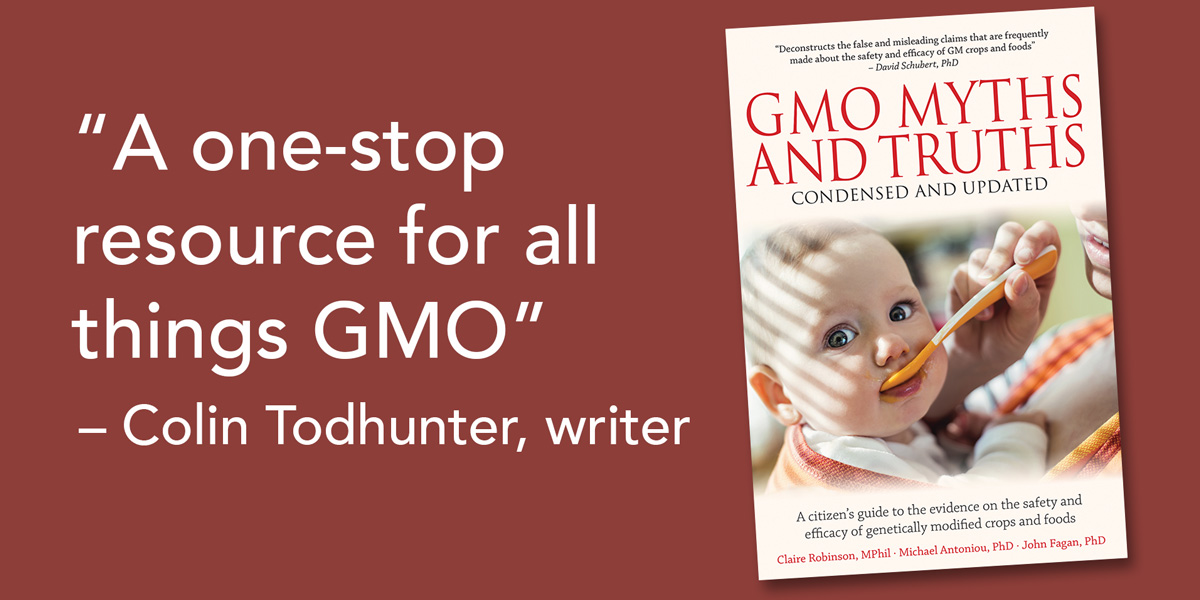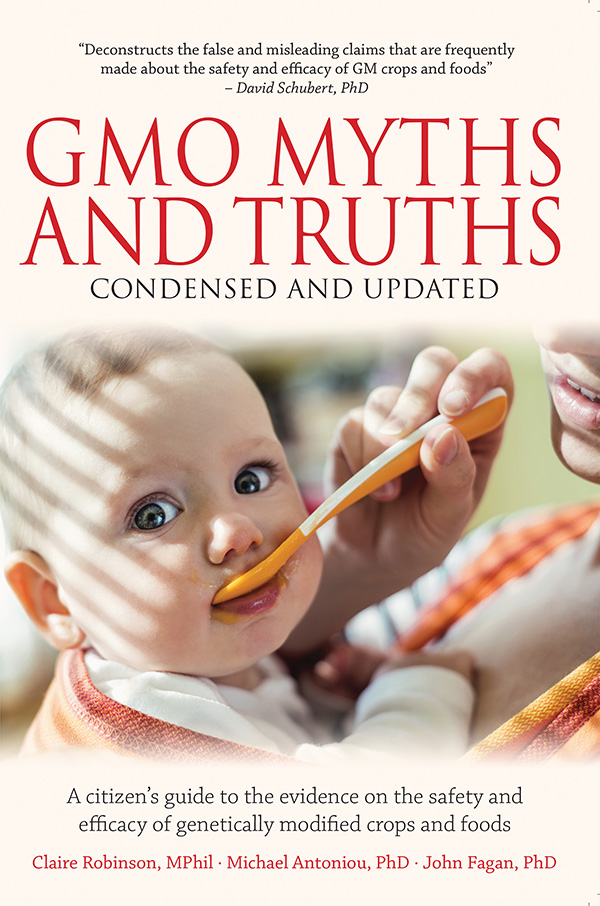
“An essential citizen’s guide to the truth about GM crops and food”
GMO Myths and Truths, the scientific case against genetically modified (GM) crops and foods, is now available as a book in a condensed and updated version (http://amzn.to/1T7AYME).
Below is a review by the food, agriculture and sustainability writer Colin Todhunter, in which he terms the book "An essential citizen’s guide to the truth about GM crops and food”.
The first edition of GMO Myths and Truths was published in 2012 and the second in 2014 as free online pdf downloads. The 2014 version is still available for free online. Together, these web publications have been downloaded hundreds of thousands of times by people all over the world.
The current third printed edition was produced in response to requests for a shorter publication in book form that could be easily read, carried around, and given to others.
It is available from Amazon, Barnes & Noble, and independent bookstores, at a price of USD 17.95. Requests for larger numbers should be directed to the US distributor, Chelsea Green.
Co-author Claire Robinson said: “Many people find it difficult to read a long and detailed pdf document on their computer, and many people and organizations would prefer to present to policymakers and industry leaders a more concise, professionally produced book. We have been asked time and again for a ‘real’ book – and here it is!”
Co-author Dr Michael Antoniou said: “This book provides evidence that dismisses claims of a scientific consensus on GM food safety in a concise, accessible and easily digestible format.”
Co-author Dr John Fagan said: “When someone tells you there is no evidence that GMOs are risky for health and the environment, give them this book. It provides the essential evidence of harm concisely and clearly, and every point is referenced to peer-reviewed scientific research publications or other reports or documents that can be checked by the reader.”
—
An essential citizen’s guide to the truth about GM crops and food
by Colin Todhunter
Counterpunch, 2 March 2016
http://www.counterpunch.org/2016/03/02/an-essential-citizens-guide-to-the-truth-about-gm-crops-and-food/
GMO Myths and Truths: A Citizen’s Guide to the Evidence on the Safety and Efficacy of Genetically Modified Crops and Foods, 3rd Edition, by Claire Robinson MPhil, Michael Antoniou PhD and John Fagan PhD
“Many who defend the use of GMO crops and foods claim that there is no evidence that any GMO is harmful to health or the environment. But this is wrong. There is plenty of sound empirical evidence of such harm, presented by qualified scientists in peer-reviewed literature. This book is a succinct summary and documentation of that evidence.” – Richard Jennings, PhD, Department of History and Philosophy of Science, University of Cambridge, UK
Before the internet, you had to head down to the library and try to access certain books and journals to get the information you required. If you were lucky, the publications were in stock and not out on loan; if not, you would have to go on a waiting list or search through what was available on the shelves. And the fact it took months or even years for a text to finally end up in print often meant certain information could already be outdated as soon as it hit the shelves. What now takes two minutes to access on the web, could have taken weeks to access before.
Yet, even with all the information readily available at the fingertips courtesy of the internet, it can still be difficult to find exactly what you want. It can be a case of spending half a day moving from site to site but not really accessing the precise bit of information required or finding everything you need in one place.
Certain fields of knowledge can be wide-ranging and draw from so many disciplines that it can be difficult to know where to begin. And what can be more confusing and indeed controversial than the area of genetically modified organisms (GMOs), food and agriculture?
There is a good deal of misinformation surrounding GMOs, and the enormous wealth of the pro-GMO lobby oils a massive PR machine that clouds the issues and presents GM in a wholly positive light. This wealth is moreover translated into political clout wherebygovernments and the GM biotech sector conspire to mislead the public and promote this technology.
The industry and its supporters say the technology is safe, increases yields, is better for farmers and the environment, uses less chemical inputs and is necessary to feed the world. They also say critics are ideologically driven, deal in pseudoscience and are Luddites who are stealing food from the bellies of the poor by campaigning against GMO. Such attacks have no basis in reality. But spin and smears are what the industry and its supporters have increasingly come to rely on. It reflects their failure to force GM onto the public and into the fields across most of the world.
A one-stop resource for all things GMO
If ever a comprehensive, one-stop resource were needed to counter the disinformation of the powerful, well-funded pro-GMO lobby, it is now. GMO Myths and Truths is a new book that does just that by presenting the scientific case against genetically modified (GM) crops and foods and deconstructing the propaganda and myths of the pro-GMO lobby. Originally published online in 2012 (second in 2014, also online), it has to date been available to the public as a free pdf download on the Earth Open Source website.
The new printed edition was produced in response to requests for a shorter publication in book form that could be easily read and passed on to others, including policy makers. It was recognised that some find it difficult to read a long document on a computer.
I for one have found the web version of GMO Myths and Truths to be an invaluable one-stop resource over the years. For the layperson, it explains in easy-to-understand terms and steps what genetic engineering is and how it is carried out. It describes and provides access to important scientific studies carried out into the safety and efficacy of GM and looks at the environmental impacts of the technology.
GMO Myths and Truths adopts a comprehensive approach to GM by moving beyond science to address wider issues related to intellectual property rights and seed patenting, alternative models of farming that are more productive and sustainable, food security, hunger and poverty. By addressing these issues, the authors demonstrate that GM is not needed and is being offered as a proxy solution for more deep-seated structural factors.
The conclusion to be drawn is that GM is a convenient diversion from the root causes of inequality, poverty and food insecurity across the globe. GM first and foremost serves the commercial interests of the biotech companies themselves.
The book itself may be described as ‘grey’ literature, in terms of it not being a peer-reviewed publication. But this in itself certainly should not (peer review has become increasingly politicised and open to corporate influence, not least where GM is concerned) and does not detract from its credibility or the validity of the arguments presented. There are in fact more than enough references to official reports, documents and peer-reviewed studies and papers for the reader to check.
New information
Like the pdf version, the book has a convenient layout, making it easy for the reader to locate specific themes and issues. What’s more, it also contains a fair amount of new information that does not appear in the previous editions. It provides updated evidence to dismiss the industry claim of a scientific consensus on GM food safety and new data that further outlines the risks that GMOs pose for health and the environment.
For example, there is information about a peer-reviewed publication by over 300 scientists that declares there is no scientific consensus that GM crops and foods are safe. The ‘trillion meal study’, so often touted by pro-GMO activists, is also deconstructed. The authors show why it fails to provide any credible evidence for GMO safety.
Other information not contained in previous versions sets out why the temporary increase in India’s cotton yield in the early 2000s was not due to GM Bt cotton and why the current decline is. The book also exposes how the GMO biotech industry’s own tests showed Bt eggplant was toxic and deconstructs the spin surrounding the crop in Bangladesh to show how it has pretty much been a failure.
The authors describe why the US government’s approval of GM crops engineered to resist the herbicides dicamba and glyphosate will create problems for farmers and health risks for consumers, and how a peer-reviewed paper shows claims that GM crops have reduced insecticide use are unreliable because they fail to consider escalating insecticide seed treatments in their calculations.
Another new addition describes how a peer-reviewed gene expression analysis confirms that rats fed an ultra-low dose of Roundup (within permitted regulatory limits) suffered liver and kidney damage.
GMO Myths and Truths addresses the concerns that many ordinary people have about the technology. Although it deals with complex issues, it uses simple language and explains the issues in a comprehensible way that appeals to both layperson and professional alike.
“To all those concerned citizens, policymakers, journalists, researchers and students who have missed a reliable, unbiased, comprehensive and readable account of plant genetic engineering and its unpredictable consequences: Here it is, and it is a splendid piece of work!” – Terje Traavik, PhD, Professor of Virology and Professor Emeritus of Gene Ecology, Faculty of Health Sciences, UiT – The Arctic University of Norway; and Scientific Director Emeritus, Genøk – Centre for Biosafety, Norway
Colin Todhunter is an extensively published independent writer and former social policy researcher based in the UK and India.
 Download an image of the book cover
Download an image of the book cover










